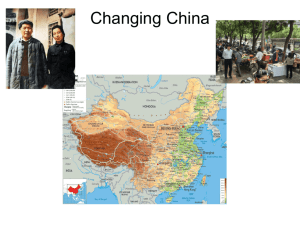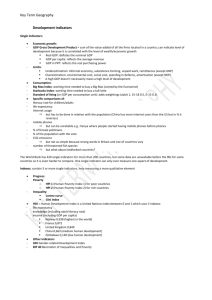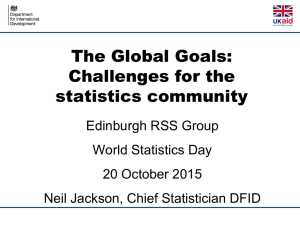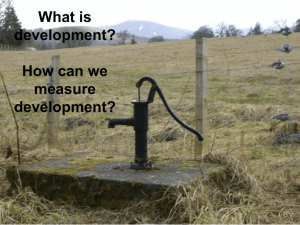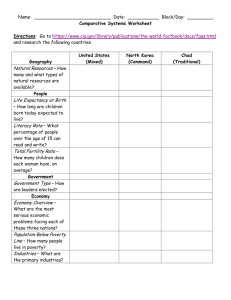Measuring poverty and inequality
advertisement
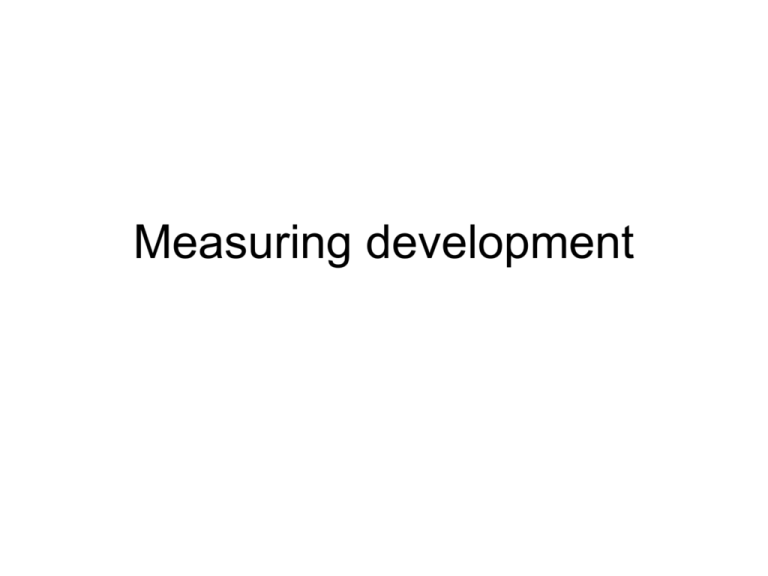
Measuring development Quantitative Measures • Measuring development using numbers and statistics, collected in each countries census: Task - which of the indicators are social? Which are economic? Social Development Indicators (health, water and education) Economic Development Indicators (income, possessions and ability to buy things) Single Economic indicators • GDP (Gross Domestic Product) – The value of goods and services produced in a country. • PPP (Purchasing Power Parity) GDP per person (average income) taking into account local exchange rates and prices. Task - what would life be like as a child growing up in these countries? • You are going to work out which of the 9 countries is the most developed and which is the poorest using a variety of quantitative indicators • Your choice of indicators is up to you Tasks When you finished the worksheet: 1. Write a definition for each measure you have used. 2. Compare your ‘total development rank’ with the ‘GNP/capita’ ranking. Which countries moved up the ranking? Which moved down? which stayed the same? Try to explain the changes. 3. Why do you think the U.N. and others use more than one development indicator? Human development Index 2007 Composite Development Indicators • The Human Development Index is the principle measure of development used by the UN since 1990 and It brings together both economic and social indicators of development: • Life expectancy. • Adult literacy and educational enrolement in Primary and Secondary. • GDP per capita. Human Development Index HDI • What do they mean for life in those countries? • Can any of the indicators be linked up together? • The HDI can be used to categorise and group different countries together Task using the HDI rankings 2007, add 2 countries to each category: • • • • • • Less Economically Developed Countries (LEDC) More Economically Developed Countries (MEDC) New Industrialised Country (NIC) Recently Industrialised Country (RIC) Developing countries Developed countries • BRIC countries • OPEC countries Human Poverty Index (HPI) • Is another composite (put together) measure of poverty. Developing countries Developed countries Gender Equity Index (GEI) • • • • Male/ female life expectancy Female/ male adult literacy Male/ female incomes 66% of the world’s illiterate people are women • Women provide 70% of the unpaid time spent in caring for family members. This unpaid work provided by women is estimated at US $11 trillion per year – one third of the global GDP • Women own 1% of the land in the world • There are only 5 female Chief Executives in the ‘Fortune 500’ corporations, the most • 7% of the world’s cabinet ministers are women Why measure the equality between men and women? • YouTube - I Dare You • YouTube - Poverty and Powerlessness for Women - Islamic Relief • YouTube - The Girl Effect • What role does gender equality play in poverty? Why measure the equality between men and women? Women provide 70% of the unpaid time spent in caring for family members. Women own 1% of the land in the world There are only 5 female Chief Executives in the ‘Fortune 500’ corporations 7% of the world’s cabinet ministers are women. 3 million lose their lives as a result of gender based violence. Democratic Republic of Congo BBC3 programme - most dangerous place for women Focus questions: 1.Why are women being attacked in the DRC? 2.How might the treatment of women in DRC affect poverty of the country? Measuring Inequality • The difference between the richest people and the poorest people within a country Differences in national income equality around the world is measured by the national Gini coefficient. The Gini coefficient is a number between 0 and 1, where 0 corresponds with perfect equality (where everyone has the same income) and 1 corresponds with perfect inequality (where one person has all the income, and everyone else has zero income). Quantative Indicators The Advantages • You can compare the development of Countries across the world and measure them by accepted indicators. • Charities, UN and countries governments can use the indicators to set goals and targets to improve their development e.g The Millenium Development Goals (MDG) Millenium Development Goals (MDG)YouTube - GOOD: The UN Millennium Declaration • Set of goals to reduce poverty • Development of the world can be measured against the success of the 8 goals eg. To achieve universal primary education. • Overall success: incomes rose, extreme poverty declined, child mortality decreased, life expectancy rose. • Asia had the fastest progress • Sub Saharan Africa in crisis, some African countries are going backward. • Latin America, Middle East and North Africa are making slow progress How is China doing? Quanitative measures: • Purchasing Power Parity has increased from $554 in 1980 to $5383 in 2007 • Its economy has grown 9.8% every year for last 10 years. • 2nd largest exporter of goods in the world • Shanghai and Piers Morgan China, human rights and poverty Piers Morgan on Shanghai YouTube - The Human cost of the Olympics YouTube - China's widening wealth gap - 17 Oct 07 • So do Quantitative indicators give us the full picture? Quantative indicators The drawbacks • Are they reliable? Are they complete? eg. Afghanistan. • Some countries are very rural eg Burkina Faso. • Definitions of indicators differ GDP/ PPP • Governments manipulate figures e.g. Zimbabwe • Inequalities within each country e.g. China or Wales • High GDP/ capita countries, does everyone benefit? E.g. Saudi Arabia Qualitative Indicators Opinions and viewpoints form reports about the ‘things’ in a country which cannot be measured Qualitative Indicators Opinions and viewpoints form reports about the ‘things’ in a country which cannot be measured Qualitative indicators YouTube - From Poverty to Power - Promotional Video These are based on viewpoints and opinions about specific aspects of poverty and inequality: • • • • • • Justice Freedom of speech Treatment of the elderly Treatment of indigenous groups The role and status of women Human rights Measuring poverty in India Quantitative indicators say: • Life Expectancy 65 years • PPP $2960 • Growth rate 7.4% • 4th largest economy in the world • Dispatches is a Channel 4 current affairs programme. It can be used as a Qualitative measure of poverty and development. Focus questions: 1. How did India develop so rapidly? 2. What issues are being raised in the programme raising about India’s poverty? 3. Why are some of the poorest people in India getting poorer? • YouTube - Untouchable? - India Measuring poverty and development in China • 44 million new mobile phone users in the past 6 months • 0 billionaires in 2002, 106 billionaires in 2008 • YouTube - Amnesty China Olympics cartoon • YouTube - China's Silenced Voices | Amnesty International • YouTube - TankMan - Tiananmen Square Protests (with John Lennon) Advantages • They focus on many issues to do with quality of life, which are important but difficult to measure. • They also focus on the link between people and their environment. • They focus on inequality as a cause of poverty Qualitative measures of poverty and bias USA Quantitative indicators: • Life Expectancy 78 years • PPP $46,970 • Growth rate -1% • Largest economy in the world • Largest exporter of services in the world • Michael Moore’s documentary Sicko is about the health service in USA. 1:40 Focus Questions: 1. What points is Michael Moore raising about poverty in USA? 2. In what ways might the documentary be biased? Where is the bias? Disadvantages • Qualitative indicators are opinions and subjective. • Reports and documentaries come with their own agendas. • Its often difficult to compare country with country. Openness of UK with extreme restriction in China. Happy Planet Index (H.P.I) • This is a new indicator of development which is a score based on both data and opinions. It looks at: 1. How satisfied people are with their lives (Qualitative) 2. How healthy they are (Life Expectancy) 3. Impact on the earth’s environment (Ecological Footprint) Global HPI | Global HPI | Explore | Happy Planet Index If every person in the world lived like a welsh person Measuring poverty and inequality has changed over time • Earlier ideas – income only GNP, GDP, PPP and the Brandt Line. • Moved on to social indicators and deprivation adult literacy, access to fresh water. • Later qualitative indicators concerned with, vulnerability, Inequality, Empowerment and human rights. • Happy Planet Index • Human rights international accountability index • Multi dimensional poverty Index (MPI) Multi-dimensional Poverty Index (MPI) Based on survey questions and a sample of the population the MPI asks: • Does the family have a dirt floor? • Does it have a decent toilet? • Does the family have to walk more than 30 minutes on foot for fresh water? • Did anyone in the family finish primary school?
